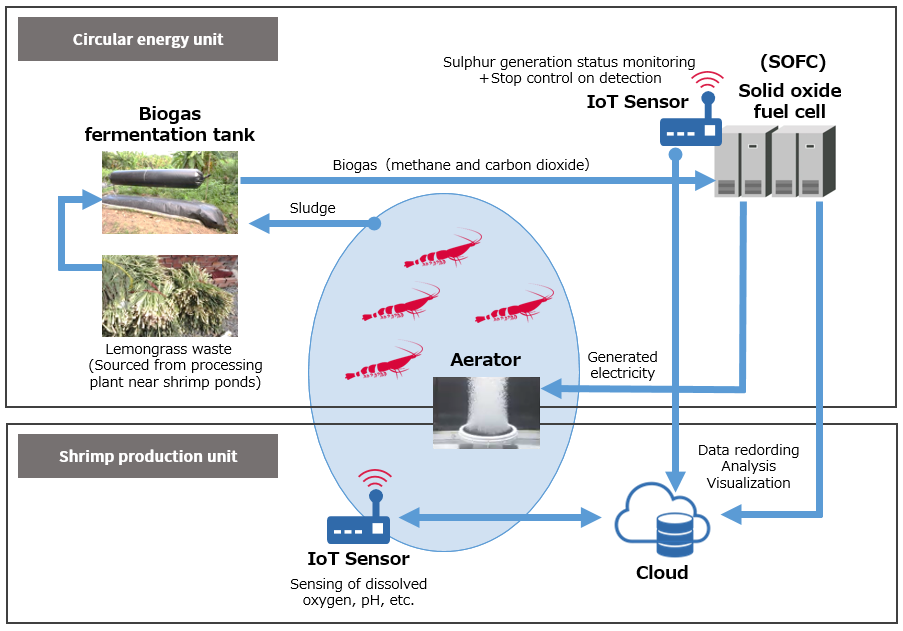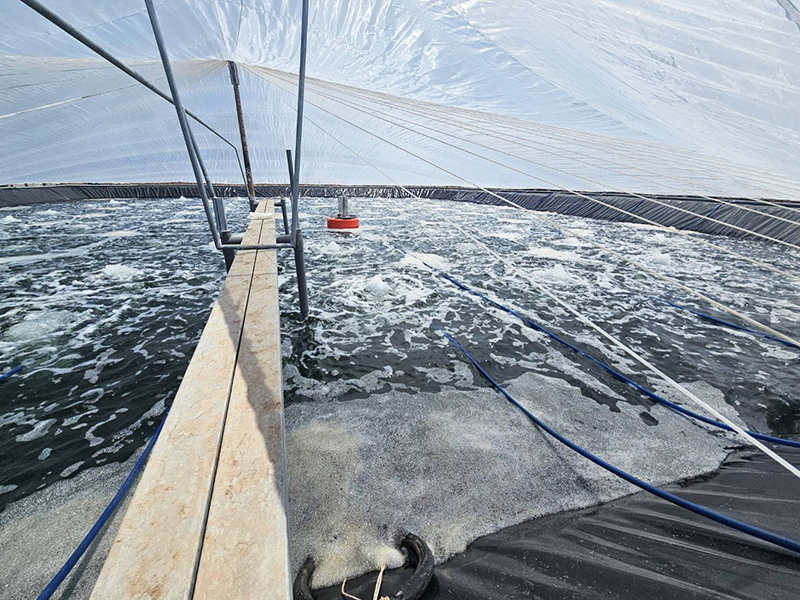Top of Page
- Links to move inside this page.
- HOME
- About IIJ
- News / CSR
- Press Releases
- 2024
- First-in-Japan Project to Utilize Green Energy and IoT in Shrimp Aquaculture
First-in-Japan Project to Utilize Green Energy and IoT in Shrimp Aquaculture
The NEDO International Demonstration Project on Japan's Technologies for Decarbonization and Energy Transition to begin in July
June 13, 2024
Yuko-Keiso Co., Ltd.
Kyushu University
Kogakuin University
Internet Initiative Japan Inc.
TOKYO - June 13, 2024 - Yuko-Keiso Co., Ltd. (Chairman: Ryuzo Ota), Kyushu University(*1) (President: Tatsuro Ishibashi), Kogakuin University (President: Yasutada Imamura), and Internet Initiative Japan Inc. (TSE Prime:3774) have developed an energy-saving shrimp aquaculture system that aims to reduce greenhouse gas emissions and provide a stable supply of electricity through the utilization of shrimp aquaculture sludge, a cause of environmental pollution in Vietnam, and is set to begin demonstration operation of the system. This demonstration is subsidized by the NEDO International Demonstration Project on Japan's Technologies for Decarbonization and Energy Transition(*2) and is being conducted by Yuko-Keiso, with Kyushu University, Kogakuin University, and IIJ participating as contractors.
This project will also be conducted with technical support from Mitsubishi Research Institute, Inc.(*3) , as well as Japanese and Vietnamese research institutes and private companies. This cross-country industry-academia collaboration is expected to make a significant contribution to the shrimp aquaculture industry, which is a major industry in Vietnam.
Energy-saving shrimp aquaculture system

Illustrative Diagram of Verification System
Improving Efficiency of Shrimp Aquaculture in Vietnam through the Implementation of an Energy-Saving Shrimp Aquaculture System
Shrimp aquaculture, a major industry in Vietnam, faces complex challenges, including insufficient electricity supply, contamination of surrounding soil and groundwater through aquaculture sludge, the generation of greenhouse gas emissions, and the spread of disease in aquaculture ponds. As such, there is an urgent need to transition to a system that reduces the occurrence of mass shrimp death and environmental pollution in the surrounding areas, and therefore has a lower environmental impact.
The energy-saving shrimp aquaculture system, which is comprised of "a circular energy unit" and "the shrimp production unit", was developed in order to solve these challenges. In "the circular energy unit", the biogas produced by mixing and fermenting aquaculture sludge and lemongrass processing waste is supplied as fuel to solid oxide fuel cells (SOFC) to generate electricity. The system is considered to be a circular energy creation technology because the electricity generated is used to power the aeration equipment and other aquaculture facilities. The system will contribute to the efforts of both the Japanese and Vietnamese governments to achieve carbon neutrality by 2050(*4) .
In "the IoT-based shrimp production unit", IoT devices are used to sense dissolved oxygen concentration, pH, and other parameters. The unit is also equipped with an IoT platform that stores and visualizes data (water quality data from the aquaculture ponds, data from the monitoring of biogas fermentation and SOFC conditions, etc.), and can analyze the correlation between the aquaculture environment and shrimp growth status through features such as threshold monitoring and an alert/notification system. The unit aims to discover the optimal shrimp aquaculture environment and improve aquaculture efficiency.
The demonstration period is scheduled to run from July 2024 to June 2025 in Tien Giang Province in southern Vietnam, and is expected to reduce CO2 emissions by approximately 40 tons per aquaculture pond (1,000 m3) and achieve a shrimp survival rate of 85% (average annual survival rate of 57%).
Anticipation for Implementation in Shrimp Farms throughout Vietnam
This system, when implemented in shrimp farms that utilize conventional aquaculture methods, is expected to reduce CO2 emissions by up to 90% or more per unit harvest weight.
The project will also make significant contributions to solving the challenges faced by shrimp farms in Vietnamese society, for instance by improving the efficiency of shrimp aquaculture and thereby increasing sales of shrimp farms and improving the environment by making effective use of aquaculture sludge-which until this point had been drained into the rivers and ocean-as an energy source.
There are said to be approximately 50,000 shrimp aquaculture businesses in the Mekong Delta Region alone, meaning that the utilization of this system will provide not only a major economic impact on Vietnam, but also have the added benefit of facilitating the distribution of higher-quality shrimp in Japan, one of the world's top consumers of shrimp.

Shrimp aquaculture pond at the project site
Role of Each Company
Yuko-Keiso Co., Ltd.
As project head, Yuko-Keiso provides comprehensive direction for the entire project, handling the design and construction of systems; on-site management; negotiations with Vietnamese government officials; coordination with contractors, subcontractors, and related parties; and more.
Kyushu University
Kyushu University aims to establish an efficient methane fermentation method using sludge from shrimp aquaculture and extraction residue generated by the lemongrass oil refinery, an unused local biomass. They are also conducting tests at Can Tho University and the project site to establish the underlying technologies needed to achieve high survival rates in high-density shrimp aquaculture in 1,000 m3 ponds.
Kogakuin University
Professor Yusuke Shiratori of the Department of Mechanical Science and Engineering, School of Advanced Engineering, is working to train personnel capable of contributing to the diffusion of fuel cells in developing countries. As the proponent of the circular energy model, which implements fuel cells in shrimp aquaculture, he is involved in the establishment of biogas-operated fuel cell technology.
Internet Initiative Japan Inc.
Measures water quality parameters such as dissolved oxygen and pH using IoT devices, in improving the productivity of shrimp aquaculture. Also designed and built the IoT platform; saves and visualizes data (water quality data from the aquaculture ponds, data from the monitoring of biogas fermentation and SOFC conditions, etc.); and provides systems such as those for data threshold monitoring and alerts/notifications.
- (*1)As prior research, Kyushu University conducted the Construction of an Intra-Regional Energy Circulation System Integrating Highly Efficient Fuel Cells and Regenerative Biogas project under the Science and Technology Research Partnership for Sustainable Development (SATREPS).
- (*2)The purpose of this subsidy is to demonstrate advanced Japanese technologies that can contribute to the realization of 3E+S (energy security, economic efficiency, environment, and safety) to an overseas audience, in order to promote the diffusion of these technologies, and to provide returns to Japan through demonstration s in overseas energy markets that are more advanced in terms of policy. Yuko-Keiso proposed the Demonstration Research of an Advanced Energy-Saving Shrimp Aquaculture System Using Local Biomass project as part of the NEDO International Demonstration Project on Japan's Technologies for Decarbonization and Energy Transition, and it was chosen for the subsidy in September 2021.
- (*3)As subcontractor, Mitsubishi Research Institute performs IoT data analysis.
- (*4)The Japanese and Vietnamese governments have both announced their goal of achieving net zero greenhouse gas emissions (carbon neutrality) by 2050.
About IIJ
Founded in 1992, IIJ is one of Japan's leading Internet-access and comprehensive network solutions providers. IIJ and its group companies provide total network solutions that mainly cater to high-end corporate customers. IIJ's services include high-quality Internet connectivity services, systems integration, cloud computing services, security services and mobile services. Moreover, IIJ has built one of the largest Internet backbone networks in Japan that is connected to the United States, the United Kingdom and Asia. IIJ was listed on the Prime Market of the Tokyo Stock Exchange in 2022.
- For more information about IIJ, visit the IIJ Web site at https://www.iij.ad.jp/en/.
The statements within this release contain forward-looking statements about our future plans that involve risk and uncertainty. These statements may differ materially from actual future events or results.
- For inquiries contact
-
Iwasaki/Okabe, International Projects Department, Yuko-Keiso Co., Ltd.
 +81-3-5720-3238
+81-3-5720-3238 info-international@yukokeiso.com
info-international@yukokeiso.com
 http://www.yukokeiso.com/ (Japanese text only)
http://www.yukokeiso.com/ (Japanese text only)
Public Relations Office, Kyushu University
 +81-92-802-2130
+81-92-802-2130 koho@jimu.kyushu-u.ac.jp
koho@jimu.kyushu-u.ac.jp
 https://www.kyushu-u.ac.jp/en/
https://www.kyushu-u.ac.jp/en/
Research Promotion Department, Kogakuin University
 +81-3-3340-3440
+81-3-3340-3440 sangaku@sc.kogakuin.ac.jp
sangaku@sc.kogakuin.ac.jp
 https://www.kogakuin.ac.jp/ (Japanese text only)
https://www.kogakuin.ac.jp/ (Japanese text only)
Arai/Masuda, Corporate Communications Department, Internet Initiative Japan Inc.
 +81-3-5205-6310
+81-3-5205-6310 +81-3-5205-6377
+81-3-5205-6377 press@iij.ad.jp
press@iij.ad.jp
- (*)All company, product, and service names used in this press release are the trademarks or registered trademarks of their respective owners.
- Related Contents
End of the page.